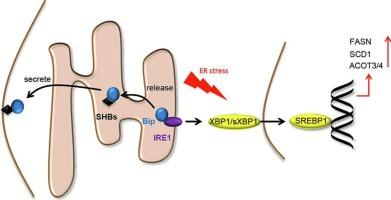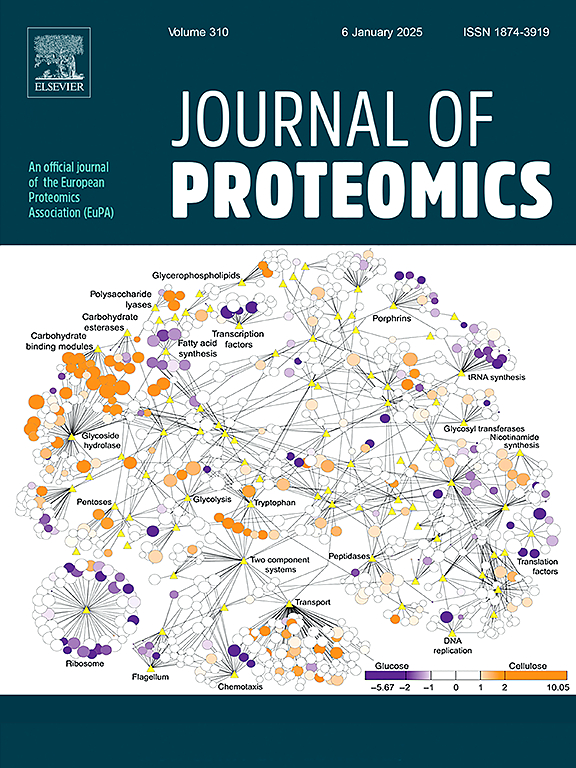Hepatitis B small surface protein hijacking Bip is initial and essential to promote lipid synthesis
IF 2.8
2区 生物学
Q2 BIOCHEMICAL RESEARCH METHODS
引用次数: 0
Abstract
To date, the molecular pathogenic mechanisms between HBsAg and liver metabolic disorders have not been fully understood. To explore the overall effects of HBsAg on liver tissues from HBV transgenic mice, proteome, interactome, and signal pathway analysis were employed to uncover the underlying mechanisms. Bioinformatics analysis of 191 differentially expressed proteins suggested that HBV upregulated the expression of multiple enzymes involved in lipid synthesis, and small HBs (SHBs) caused lipid accumulation in cells. Further studies showed that SHBs bound to binding immunoglobulin protein (Bip), which normally functions in cell homeostasis against the unfolded protein response (UPR) signaling via occupying inositol-requiring enzyme 1 (IRE1). Hijacking Bip by SHBs alleviated the inhibition of post-endoplasmic reticulum (ER) signaling and sequential activation of the IRE1 downstream transcription factors involved in lipid synthesis, such as spliced X-box binding protein 1 (sXBP1) and sterol regulatory element-binding protein 1 (SREBP1), leading to lipid metabolism disorder. The restoration of Bip can alleviate ER stress, and block the sequential post-ER signaling caused by SHBs. This study revealed a new pathway through which SHBs promote lipid disorder, and suggests that Bip may serve as a novel target for intervention in HBV related liver diseases.
Significance
In this study, we found a new pathway promoting the lipid disorder by SHBs through quantitative proteomics studies, and Bip may serve as a novel target for intervention in HBV related liver diseases. These findings highlight a novel role of SHBs in regulating cell lipid metabolism and provide an insight into the relationship between HBV infection and liver fatty disorders, which may serve as a potential therapeutic target for intervention of HBV related liver diseases.

乙型肝炎小体表面蛋白劫持 Bip 是促进脂质合成的初始和必要条件。
迄今为止,HBsAg 与肝脏代谢紊乱之间的分子致病机制尚未完全明了。为了探索 HBsAg 对 HBV 转基因小鼠肝脏组织的整体影响,我们采用了蛋白质组、相互作用组和信号通路分析来揭示其潜在机制。对 191 个差异表达蛋白的生物信息学分析表明,HBV 上调了多种参与脂质合成的酶的表达,小 HBs(SHBs)导致细胞内脂质积累。进一步的研究表明,SHBs 与结合免疫球蛋白(Bip)结合,Bip 通常通过占据肌醇需要酶 1(IRE1),在细胞平衡中发挥对抗未折叠蛋白反应(UPR)信号的功能。SHBs 劫持 Bip 可减轻内质网(ER)后信号传导的抑制以及 IRE1 下游转录因子(如剪接 X-box 结合蛋白 1(sXBP1)和固醇调节元件结合蛋白 1(SREBP1))参与脂质合成的顺序激活,从而导致脂质代谢紊乱。Bip的恢复可以缓解ER应激,阻断SHBs引起的ER后信号传导。这项研究揭示了 SHBs 促进脂质代谢紊乱的新途径,并提示 Bip 可作为干预 HBV 相关肝病的新靶点。意义:在这项研究中,我们通过定量蛋白质组学研究发现了SHBs促进脂质紊乱的新途径,Bip可能成为干预HBV相关肝病的新靶点。这些发现凸显了 SHBs 在调控细胞脂质代谢中的新作用,并为 HBV 感染与肝脏脂肪紊乱之间的关系提供了新的视角,可能成为干预 HBV 相关肝病的潜在治疗靶点。
本文章由计算机程序翻译,如有差异,请以英文原文为准。
求助全文
约1分钟内获得全文
求助全文
来源期刊

Journal of proteomics
生物-生化研究方法
CiteScore
7.10
自引率
3.00%
发文量
227
审稿时长
73 days
期刊介绍:
Journal of Proteomics is aimed at protein scientists and analytical chemists in the field of proteomics, biomarker discovery, protein analytics, plant proteomics, microbial and animal proteomics, human studies, tissue imaging by mass spectrometry, non-conventional and non-model organism proteomics, and protein bioinformatics. The journal welcomes papers in new and upcoming areas such as metabolomics, genomics, systems biology, toxicogenomics, pharmacoproteomics.
Journal of Proteomics unifies both fundamental scientists and clinicians, and includes translational research. Suggestions for reviews, webinars and thematic issues are welcome.
 求助内容:
求助内容: 应助结果提醒方式:
应助结果提醒方式:


